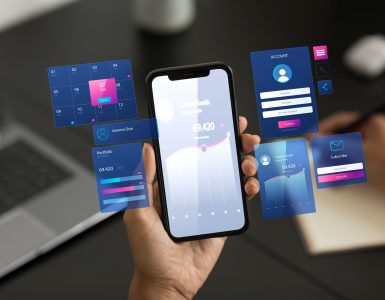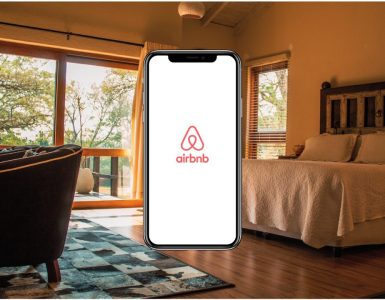In the dynamic realm of mobile application development, the user interface (commonly known as UI) and user experience (UX) play pivotal roles in shaping the success of an application.
As technology continues to grow, the requirement of crafting a seamless and engaging UI/UX has become more pronounced than ever before.
What is UI/UX in mobile app development?
- UI refers to an app’s visual elements and layout, encompassing everything a user interacts with – buttons, screens, pages, etc.
- On the other hand, UX delves into the user’s overall experience with the application, encompassing ease of use, accessibility, and overall satisfaction.
What are the Key Elements of Effective UI/UX?
When designing an app, you need to consider certain key elements that come under the umbrella of UI/UX development.
Intuitive Navigation
At the core of a successful UI/UX is intuitive navigation. Users should be able to effortlessly navigate through an app without encountering confusion.
Clear and logical paths, easily recognizable icons, and well-organized menus contribute to an intuitive navigation experience. When users can accomplish tasks seamlessly, it enhances the overall usability of the app.
Visual Appeal
Visual appeal goes beyond aesthetics; it directly influences user engagement. An eye-catching design can captivate users from the moment they open the app, setting a positive tone for their interaction.
Consistent branding, thoughtful use of colors, and visually pleasing graphics contribute to the overall appeal.
Striking the correct balance between creativity and simplicity ensures that the visual elements enhance rather than detract from the user experience.
Responsiveness
In the fast-paced world of mobile technology, users expect instant responsiveness. A laggy or unresponsive interface can frustrate users and lead to disengagement.
Therefore, optimizing the app’s responsiveness is paramount. This involves ensuring swift loading times, smooth transitions between screens, and a seamless response to user inputs.
A responsive UI/UX not only enhances user satisfaction but also reflects positively on the app’s reliability.
User Feedback and Iteration
Incorporating mechanisms for user feedback and continuously iterating on the design based on user input.
User feedback provides valuable insights into the app’s strengths and areas for improvement. Continuous iteration ensures that the app evolves to meet changing user expectations.
Clarity in Communication
Clear and concise communication through text, icons, and other visual elements to guide users and convey information.
Clarity in communication is essential for users to understand the purpose of each element and successfully navigate through the app.
Loading Time Optimization
Optimizing the app’s loading times to ensure quick access to content and features. Users are highly likely to stay engaged if they can access the app’s functionalities promptly, minimizing waiting times.
The Impact on User Engagement
Now, coming to the practical results. How UI/UX designing is driving user engagement and why you should focus on UI/UX as an app developer.
User Satisfaction
- Intuitive Design: Users will prefer to use apps where they can easily understand how to navigate and complete tasks without unnecessary complexity. An intuitive design reduces the learning curve, leading to higher user satisfaction.
- Seamless User Journey: When users have a smooth experience from the moment they open the app to completing their intended tasks, they are more likely to engage with the app consistently, fostering a positive perception.
- Reduced Friction Points: Users are more likely to stay engaged when they encounter fewer obstacles or frustrations. Eliminating unnecessary steps, streamlining processes, and providing clear instructions contribute to a more satisfying experience.
Retention Rates
- Positive First Impressions: Users often decide within the first few interactions whether to continue using an app. A well-crafted UI captures their attention and encourages them to explore further, positively impacting retention rates.
- Consistent User Experience: Users appreciate familiarity. When updates or new features align with the existing design language, users are more likely to adapt easily, reducing the likelihood of abandoning the app due to drastic changes.
- Personalized Interactions: Apps that understand and cater to individual user preferences create a sense of personalization. This can include personalized recommendations, content, or features, fostering a stronger connection with the user. Consequently, you’ll see better engagement.
- Swift Responsiveness: Users appreciate an app that responds promptly to their actions. A laggy or unresponsive interface can lead to frustration and negatively impact retention rates.
Common UI/UX Challenges
While the importance of UI/UX is clear, the journey to creating a seamless experience is not without its challenges. Common hurdles include:
Cross-Device Compatibility
With a diverse range of devices in the market, ensuring a consistent and optimized experience across various screen sizes and resolutions can be challenging.
Accessibility Concerns
Ensuring that the mobile app is accessible to users with disabilities poses a significant challenge. This includes considerations for those with visual, auditory, or motor impairments.
Balancing Complexity and Simplicity
Striking the right balance between feature-rich interfaces and simplicity is an ongoing challenge. Including too many features can overwhelm users, while a minimalist approach might lead to a lack of functionality.
Best practices for UI/UX design in mobile app development
To navigate these challenges successfully, adhering to UI/UX best practices is crucial. So, what exactly are these best practices? Let’s find out!
User Research
- Practice: Conduct thorough user research to understand the target audience, their behaviors, and preferences.
- Benefit: This practice helps you, as an app designer, create designs that resonate with users, address their pain points, and provide solutions that genuinely meet their needs.
Prototyping and Testing
- Practice: Create prototypes and test designs before full implementation to identify potential issues early in the development process.
- Benefit: Early testing helps uncover usability issues, allowing for adjustments that can save time and resources in the long run.
Continuous User Feedback
- Practice: Establish channels for continuous user feedback throughout the development lifecycle.
- Benefit: Regular feedback loops enable you to make informed decisions, prioritize enhancements, and ensure that the final product aligns with user expectations.
Consistency Across Platforms
- Practice: Maintain a consistent design language across different platforms (iOS, Android) to provide a uniform experience.
- Benefit: Consistency enhances user familiarity, making it easier for users to transition between platforms and reducing the learning curve.
Usability Testing
- Practice: Conduct usability testing with real users to evaluate the app’s ease of use and identify areas for improvement.
- Benefit: Usability testing provides valuable insights into how users interact with the app, helping to refine the design for optimal user experience.
Prioritize Accessibility
- Practice: Design with accessibility in mind, ensuring the app is usable by individuals with disabilities.
- Benefit: Prioritizing accessibility not only broadens the app’s user base but also aligns with ethical considerations and legal requirements.
Mobile-First Design
- Practice: Adopt a mobile-first design approach, considering the constraints and opportunities of mobile devices from the outset.
- Benefit: This approach ensures that the app is optimized for mobile users, considering smaller screens and touch interactions as primary design considerations.
Performance Optimization
- Practice: Optimize the app’s performance to ensure swift loading times and smooth interactions.
- Benefit: Users are more likely to engage with an app that responds quickly to their actions, contributing to a positive overall experience.
Clear Calls to Action (CTA)
- Practice: Use clear and prominent calls to action to guide users toward desired actions.
- Benefit: Clear CTAs reduce user confusion, making it evident what actions are available and encouraging users to take specific steps.
Stay Updated on Design Trends
- Practice: Stay informed about current design trends and emerging technologies.
- Benefit: Keeping up with trends ensures that the app’s design remains fresh, relevant, and aligned with user expectations.
When you incorporate these best practices into the UI/UX design process, you can create mobile apps that not only meet functional requirements but also provide a delightful and user-centric experience.
Frequently Asked Questions (FAQs) – UI/UX in Mobile App Development
How can I effectively gather user feedback during the development process?
To gather user feedback effectively, implement tools like in-app surveys, usability testing, and beta testing programs. Encourage users to share their thoughts through feedback forms within the app. Additionally, leverage analytics to track user behavior and identify areas for improvement.
How can I address cultural considerations in UI/UX design for a global audience?
Consider cultural nuances in color choices, imagery, and iconography to ensure your app resonates with a diverse audience. Conduct user research in different regions to understand cultural preferences and adapt the design accordingly for a more inclusive experience.
Are there specific design considerations for dark mode implementation?
Dark mode has gained popularity, and its implementation should focus on maintaining readability and visual hierarchy. Adjust contrast ratios, use adaptive color schemes, and consider users’ preferences for a comfortable and visually appealing dark mode experience.
What considerations should be made for designing UI/UX in augmented reality (AR) applications?
For AR applications, prioritize a seamless blend of virtual and real elements. Focus on spatial awareness, minimize cognitive load, and ensure that AR interactions enhance rather than distract from the user’s physical environment. Prioritize user safety and comfort.
How can I adapt UX/UI design for devices with foldable screens or unique form factors?
For foldable screens and unique form factors, prioritize responsive design principles. Ensure that the app adjusts seamlessly to different screen sizes and orientations. Leverage the additional screen real estate creatively, providing enhanced functionality without compromising the user experience on standard screens.
What strategies can I employ to encourage users to explore additional features within the app?
Implement interactive onboarding experiences, highlight key features at strategic points, and use subtle nudges or tooltips to draw attention to additional functionalities. Gamification elements, such as achievements or rewards, can also motivate users to explore and engage more deeply with the app.
Wrapping up
From making things easy to look at to ensuring the app responds like a good friend, UI/UX is the key. It’s not just about creating an app; it’s about creating an experience users can’t get enough of.
So, let’s keep designing apps that not only meet but exceed what users dream of. Happy designing!






Add comment